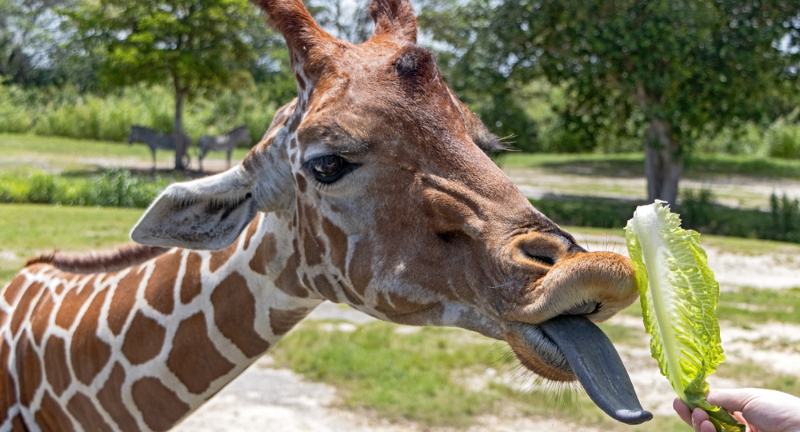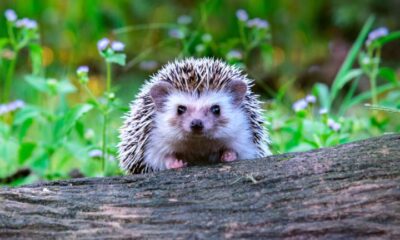ANIMALS
20 Fun Facts About Giraffes
Published
1 year agoon

Shutterstock
Giraffes, the tallest land animals on Earth, captivate the imagination with their long necks, distinctive coat patterns, and graceful demeanor. These gentle giants are native to the savannas, grasslands, and open forests of Africa, where they roam in search of food. Despite their serene appearance, giraffes face numerous challenges, including habitat loss, poaching, and predation. They exhibit fascinating behaviors and adaptations that enable them to thrive in their environments, from their unique feeding habits to their social interactions. This collection of facts sheds light on the remarkable biology of giraffes, their role in the ecosystem, and the efforts being made to conserve these iconic creatures for future generations.
Tallest Mammals on Earth

Shutterstock
Giraffes are the tallest living terrestrial animals, with adult males reaching heights of up to 18 feet (5.5 meters) and females slightly shorter. Their towering stature is largely due to their long necks, which alone can measure up to 6 feet (1.8 meters). This height advantage allows giraffes to access leaves and buds in the treetops that few other animals can reach, giving them a significant advantage in the habitats they occupy across Africa.
Long Neck With Few Vertebrae

Shutterstock
Despite their long necks, giraffes have the same number of vertebrae in their necks as humans—just seven. Each cervical vertebra is super-sized, however, and can be over 10 inches (25 centimeters) long. This unique adaptation not only supports their long necks but also provides them the necessary range of motion to reach food sources and scan for predators.
Unique Coat Patterns

Shutterstock
Each giraffe has a unique coat pattern that acts like a human fingerprint—no two giraffes have exactly the same pattern. These patterns serve several purposes, including camouflage, temperature regulation, and identification among individuals. The patches are surrounded by a network of blood vessels and large sweat glands, which help regulate body temperature in the hot African climate.
Highly Social Animals

Shutterstock
Giraffes are social animals that form groups, known as towers, which typically consist of 10 to 20 individuals but can include up to 50. These groups are often fluid, with members joining or leaving at will. Towers are usually non-territorial and are composed of females, their offspring, and young males, while adult males tend to be solitary or form bachelor groups.
Long Gestation Period

Shutterstock
Giraffes have one of the longest gestation periods among mammals, lasting approximately 15 months (about 453 to 464 days). This lengthy gestation period is necessary for the development of their large offspring, which are born well-developed and can stand and run within a few hours of birth. The long pregnancy also contributes to their slow population growth rate.
Unique Feeding Habits

Shutterstock
Giraffes are browsers that primarily feed on leaves, shoots, and fruits of woody plants, with a particular preference for acacia species. Their long tongues, which can be up to 18 inches (45 centimeters) long, are prehensile and allow them to grasp and strip leaves from branches. This tongue is also tough and covered in thick, sticky saliva to protect against thorns.
Impressive Cardiovascular System

Shutterstock
To pump blood up to their long necks and heads, giraffes have a powerful heart that can weigh up to 25 pounds (11 kilograms) and measures about 2 feet (0.6 meters) long. Their blood pressure is also the highest of any land mammal, which is necessary to overcome the gravitational pull when raising blood to such heights. Specialized valves and a unique vascular system prevent blood from rushing to their heads when they bend down to drink.
Fast and Agile

Shutterstock
Despite their height and seemingly awkward shape, giraffes are capable of speeds up to 35 miles per hour (56 kilometers per hour) over short distances and can sustain 10 miles per hour (16 kilometers per hour) over longer distances. This speed, combined with their long stride, allows them to escape from predators effectively.
Complex Communication

Shutterstock
Giraffes are not silent creatures; they communicate using various sounds, including moans, snores, hisses, and grunts. Recent studies have also discovered that giraffes produce a low-frequency sound, inaudible to humans, known as infrasound, which they might use to communicate over long distances.
Sleeping Habits

Shutterstock
Giraffes sleep much less than most mammals, typically only for about 20 minutes to 2 hours in a 24-hour period. They often sleep standing up to remain vigilant against predators, but they can also lie down with their neck curled back and their head resting on their rump.
Incredible Vision

Shutterstock
With their great height and large, bulging eyes, giraffes have excellent vision that allows them to spot predators from far away. Their eyesight plays a crucial role in their survival, enabling them to keep a constant watch for threats while they feed in the open savannas.
Vulnerable Status

Shutterstock
Giraffes are currently classified as vulnerable to extinction by the International Union for Conservation of Nature (IUCN), with some subspecies being listed as critically endangered. Habitat loss, poaching, and conflicts with humans are the main threats to their survival. Conservation efforts are underway to protect these majestic animals and their habitats.
Diverse Subspecies

Shutterstock
There are several recognized subspecies of giraffes, each with distinct coat patterns, geographic ranges, and habitats. These subspecies include the Masai giraffe, the reticulated giraffe, and the Rothschild’s giraffe, among others. The diversity among subspecies reflects the giraffe’s adaptability to different environments across Africa.
Water-Independent

Shutterstock
Giraffes can go for weeks without drinking water, getting most of their moisture from the leaves they eat. This adaptation is particularly beneficial in arid environments where water is scarce. When they do drink, their spread-legged stance and the ability to rapidly gulp water make them less vulnerable to predators.
Protective Mothers

Shutterstock
Female giraffes are fiercely protective of their offspring. Mothers will aggressively defend their calves against predators, delivering powerful kicks with their long legs that can cause serious injury or death to lions, hyenas, and other threats. This maternal instinct ensures a higher survival rate for their young in the wild.
Predators and Threats

Shutterstock
While adult giraffes are less vulnerable to predation due to their size and strength, calves are at risk from lions, leopards, hyenas, and wild dogs. Adult giraffes’ primary defense against these predators is their powerful kick, which can be fatal. Human activities, such as habitat destruction and illegal hunting, also pose significant threats to giraffe populations.
Life Span in the Wild

Shutterstock
Giraffes have a relatively long lifespan, living up to 25 years in the wild. Their lifespan can extend up to 28-30 years in captivity, where they are protected from predators and receive regular veterinary care. However, their survival in the wild is heavily influenced by environmental conditions, predation, and human activities.
Contribution to Ecosystem

Shutterstock
As browsers, giraffes play a crucial role in their ecosystems by controlling the growth of vegetation, which in turn influences the diversity of plant and animal communities. Their feeding habits help to shape the landscape, allowing sunlight to reach the ground and encouraging the growth of a variety of plant species.
Cultural Significance

Shutterstock
Giraffes have been part of human culture and folklore in Africa for thousands of years, symbolizing grace, peace, and individuality. They are depicted in ancient rock art, and today, they continue to be celebrated in art, literature, and media around the world. Their unique appearance and gentle demeanor have made them iconic symbols of the African wilderness.
Conservation Efforts

Shutterstock
Conservation efforts for giraffes include habitat protection, anti-poaching patrols, and research to better understand their ecology and behavior. Organizations and governments are working together to create and enforce laws that protect giraffes, as well as to establish protected areas where they can thrive. These efforts are crucial for ensuring the survival of giraffes for future generations.
Conclusion

Shutterstock
Giraffes, with their long necks and distinctive coat patterns, are among the most iconic creatures of the African savanna. As we’ve explored the fascinating world of giraffes through these facts, we’ve seen not only the unique adaptations and behaviors that allow them to thrive in their environment but also the challenges they face in a rapidly changing world. From their remarkable height that facilitates feeding on the tallest trees to their specialized cardiovascular system that manages blood flow to and from their heads, giraffes are a testament to the wonders of evolution. However, their survival is threatened by human activities, including habitat destruction, poaching, and climate change. The conservation of giraffes presents a critical challenge for humanity, requiring concerted efforts to protect these majestic animals and their habitats. Through understanding and appreciating the value of giraffes, we can inspire actions that support their conservation and ensure that future generations can continue to marvel at their grace and beauty in the wild.
More Amazing Animals+
-


Why We Love Penguins
-


More – Orphaned bear cubs playing in tree and post-rescue…
-


30 Most Beautiful Birds In North America
-


How to Turn Your Backyard Into a Thriving Wildlife Sanctuary
-


Today a 12 foot Great White shark was spotted less…
-


19 Strange Creatures Named After Food You’ve Never Heard Of
-


Why Giraffes Are Actually So Scary
-


Ducks Are Cooler Then You Think, Here’s Why
-


Fascinating Ferrets: 25 Facts About These Mischievous Creatures
-


Secrets of the Squirrel Kingdom: 25 Amazing Facts
-


24 Most Interesting Facts About The Amazon River
-


The Adorable World of Hedgehogs: 25 Things You Didn’t Know!
